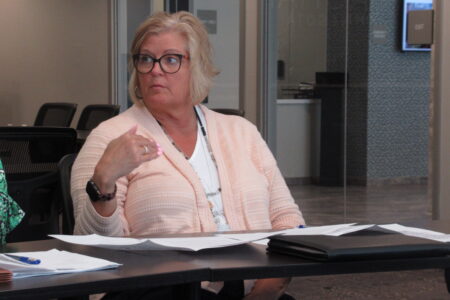Marshall School District projects $1.7M deficit for 2025-26
MARSHALL — After seeing a $1.1 million deficit for the 2024-25 school year ending balances, the Marshall Public School District is projecting a $1.7 million deficit for the upcoming school year.
Enrollment decrease, inflation and legislative funding cuts factor into the shortfall.
“There are so many unknowns right now at the state and federal level when it comes to school funding, so we’re just doing our best with the information that we do have,” Marshall Director of Finance Sarah Kirchner said at Monday’s school board meeting in a 2025-26 preliminary budget review presentation. “We are projecting a planned deficit again for Fiscal Year 2026, of just over $1.7 million.”
The fiscal year begins July 1 next month and runs through June 30, 2026.
The district covered the $1.1 million 2024-25 deficit with reserves, which Kirchner noted is not a long-term solution and is typically used for emergencies rather than operational costs.
A large part of the deficit is the state’s general education formula not keeping up with inflation rates.
Kirchner detailed that the formula was set at $7,281 per adjusted pupil unit (APU) in 2025, trailing the rate of inflation, and causing a difference of $1,356 or 18.6% for each student this fiscal year.
“Had the allowance increased by the rate of inflation each year since 2003, the 2025 allowance per pupil would be $8,637,” Kirchner said.
For 2026, the general education formula allowance will increase about $200 per APU for $7,481 per adjusted pupil unit.
“One thing I just want to reiterate is that in 2022, we received about ($1.6) million in federal COVID funding. In 2023, it was $2 million, 2024 was $1.5 million. That (funding) now has ended,” Kirchner said. “We, in 2025, did not receive any funding related to the pandemic. I think what’s happening now has just been prolonged with receiving that additional federal funding over the last three years.”
Kirchner took a look at student enrollment numbers, and the district is expecting a reduction in the years to come, based on new students coming in and going. This further offers a financial challenge, as student count is a factor of driving in a majority of the district’s revenue.
Marshall Public Schools, as a collective, saw a slight increase of seven students in 2023-24, yet a significant drop of 41 students for the 2024-25 school year. The district is projecting another enrollment decrease of around 26 students for 2025-26, with a continuing decline each year to 2028.
“If you’re looking at those 26 students that we’re projecting to have less of in the next coming year, according to the general education funding formula of a little over $7,000 (per pupil), that equates for a loss of revenue of about $195,500 in (general education) funding,” Kirchner said.
“This past year, a total of 323 students came and attended Marshall Public Schools from surrounding districts. But, students that are in Marshall and attending schools in other districts through open enrollment, that number for this past year was at 344 students,” Kirchner added. “That actually creates a negative difference for us. So, we have more kids open-enrolling out of Marshall Public Schools than we do coming in.”
Factors as to why students may attend other districts could be due to distance of residency, extra curricular activities, class options or athletics.
The school board recently directed the district to cut $350,000 from operations to begin offsetting the 2025-26 deficit, which was approved at the April 7 board meeting. Specifically, software purchasing will be reduced by at least $7,000, supply budgets by 1%, expenditures for high school programming by $5,500 (which could be offering one less course), eliminating two media aide staffing positions, and reorganizing custodial and nursing staffing for a savings of at least $25,000 and $11,000 respectively.
There also is a possibility of the state closing the Alternative Teacher Compensation program, known as QComp, in Fiscal Year 2027, which superintendent Jeremy Williams has said the district receives over $700,000 annually from QComp for teacher pay and incentives.
“Another topic we’ve heard about is the reduction to special education transportation … The (special education) cross-subsidy aid will likely be decreased in future years. None of this is great news for us. Unfortunately, student support personnel aid is going to be reduced, library aid, student lunch reimbursement is getting reduced,” Kirchner said. “There’s a lot of things that we’re up against.”
Unless a new resource of funding comes through, Kirchner mentioned that Fiscal Year 2027 could see a complete loss of cash flow.
“As soon as 2027, without any additional revenues or funding generation, we’re definitely going to run out of funding. This means that we will not cash flow throughout the year,” Kirchner said. “We have a couple big times during the year that we have to make some large payments … I know our bond payments come in at about $2 million. We just made one of those. That’s twice a year. Then always in June, we have our large payout for the summer to pay our teachers. Last year, I looked that up, it was about $9.1 million in one payroll. We need to be able to cash flow.”
In addition to the $350,000 in operation cuts for the upcoming school year, the district will also use another $800,000 from reserves.
“We don’t want to be spending our reserve balances, but we did host some listening sessions with our MPS staff, and we did receive a significant amount of feedback expressing the desire to spend down those reserve funds,” Kirchner said. “We’re anticipating that after these two years, we will have spent down at least 10% of that, and we will get to a point where we need to make some changes, whether that be through a referendum or additional cuts.”
The Marshall school board has expressed in recent meetings the possibility of pursuing a voter-based operating referendum.
Marshall’s last operating referendum was in 2018 for $675 per pupil, and has not had one in place since.
“(If pursued and passed), we wouldn’t see that revenue come in until Fiscal Year 2027, which does give us a positive fund balance, allowing the district to cash flow year after year, especially during those high expenditure months,” Kirchner said.
Information on a possible operating referendum is expected to be released by the district in the coming weeks, with further discussions taking place at the upcoming board meetings, open to the public. The district will have to call for an election by Aug. 12 if they choose to pursue a Nov. 4 referendum voting day.
The next school board meeting is scheduled for June 16 at 5:30 p.m. in the district office development room at the middle school.






